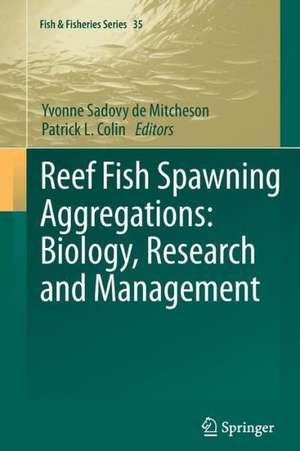Reef Fish Spawning Aggregations: Biology, Research and Management: Fish & Fisheries Series, cartea 35
Editat de Yvonne Sadovy de Mitcheson, Patrick L. Colinen Limba Engleză Paperback – 28 ian 2014
This book provides comprehensive and practical coverage of the biology, study and management of reef fish aggregations, exploring their how, when, where, and why. It explores ways to better protect, study, manage and conserve them, while identifying key data gaps and questions. The text is extensively illustrated with many unique, never before published, photographs and graphics. Case studies on over 20 interesting and important fishes are included, outlining their biology and fisheries and highlighting major concerns and challenges.
| Toate formatele și edițiile | Preț | Express |
|---|---|---|
| Paperback (1) | 1233.20 lei 6-8 săpt. | |
| SPRINGER NETHERLANDS – 28 ian 2014 | 1233.20 lei 6-8 săpt. | |
| Hardback (1) | 1236.99 lei 6-8 săpt. | |
| SPRINGER NETHERLANDS – 6 noi 2011 | 1236.99 lei 6-8 săpt. |
Din seria Fish & Fisheries Series
- 18%
 Preț: 1116.09 lei
Preț: 1116.09 lei - 18%
 Preț: 978.12 lei
Preț: 978.12 lei - 18%
 Preț: 1242.66 lei
Preț: 1242.66 lei - 18%
 Preț: 1223.74 lei
Preț: 1223.74 lei - 18%
 Preț: 1224.85 lei
Preț: 1224.85 lei - 18%
 Preț: 942.76 lei
Preț: 942.76 lei - 18%
 Preț: 1233.06 lei
Preț: 1233.06 lei - 15%
 Preț: 647.40 lei
Preț: 647.40 lei - 18%
 Preț: 2490.41 lei
Preț: 2490.41 lei - 18%
 Preț: 1239.19 lei
Preț: 1239.19 lei - 24%
 Preț: 1301.39 lei
Preț: 1301.39 lei - 18%
 Preț: 2099.91 lei
Preț: 2099.91 lei - 15%
 Preț: 650.19 lei
Preț: 650.19 lei - 18%
 Preț: 1837.88 lei
Preț: 1837.88 lei - 18%
 Preț: 1227.21 lei
Preț: 1227.21 lei - 18%
 Preț: 1230.84 lei
Preț: 1230.84 lei - 18%
 Preț: 947.35 lei
Preț: 947.35 lei - 18%
 Preț: 961.86 lei
Preț: 961.86 lei - 18%
 Preț: 1234.00 lei
Preț: 1234.00 lei - 18%
 Preț: 1226.11 lei
Preț: 1226.11 lei - 18%
 Preț: 1224.99 lei
Preț: 1224.99 lei - 18%
 Preț: 1234.00 lei
Preț: 1234.00 lei - 18%
 Preț: 1234.62 lei
Preț: 1234.62 lei - 15%
 Preț: 716.15 lei
Preț: 716.15 lei - 18%
 Preț: 1236.19 lei
Preț: 1236.19 lei - 18%
 Preț: 975.73 lei
Preț: 975.73 lei - 18%
 Preț: 1229.91 lei
Preț: 1229.91 lei - 18%
 Preț: 2325.45 lei
Preț: 2325.45 lei - 18%
 Preț: 995.34 lei
Preț: 995.34 lei - 18%
 Preț: 1230.66 lei
Preț: 1230.66 lei
Preț: 1233.20 lei
Preț vechi: 1503.90 lei
-18% Nou
Puncte Express: 1850
Preț estimativ în valută:
235.97€ • 246.37$ • 195.30£
235.97€ • 246.37$ • 195.30£
Carte tipărită la comandă
Livrare economică 05-19 aprilie
Preluare comenzi: 021 569.72.76
Specificații
ISBN-13: 9789401783897
ISBN-10: 9401783896
Pagini: 644
Ilustrații: XXII, 622 p.
Dimensiuni: 155 x 235 x 34 mm
Greutate: 0.89 kg
Ediția:2012
Editura: SPRINGER NETHERLANDS
Colecția Springer
Seria Fish & Fisheries Series
Locul publicării:Dordrecht, Netherlands
ISBN-10: 9401783896
Pagini: 644
Ilustrații: XXII, 622 p.
Dimensiuni: 155 x 235 x 34 mm
Greutate: 0.89 kg
Ediția:2012
Editura: SPRINGER NETHERLANDS
Colecția Springer
Seria Fish & Fisheries Series
Locul publicării:Dordrecht, Netherlands
Public țintă
ResearchCuprins
Preface.- Chapter 1 – Revisiting Spawning Aggregations: Definitions and Challenges.-Chapter 2 - Ecosystem aspects of species that aggregate to spawn.-Chapter 3 - Why spawn in aggregations?.-Chapter 4 – Spawning Aggregations is Reef Fishes; Ecological and Evolutionary Processes.- Chapter 5 - Timing and location of Aggregation and spawning in reef fishes.- Chapter 6 - oceanography of the planktonic stages of Aggregation Spawning Reef fishes.- Chapter 7 - Aggregation Spawning: Biological Aspects of the Early Life History.- Chapter 8 - Fishery and biological implications of fishing spawning aggregations, and the social and economic importance of aggregating fishes.- Chapter 9 – Studying and Monitoring Aggregating Species.- Chapter 10 - The role of local ecological knowledge in the conservation and management of reef fish spawning aggregations.- Chapter 11 - Management of Spawning Aggregations.- Chapter 12 - Species case studies.- Chapter 13 - Conclusion.- Glossary.- Abbreviations.- Index.
Textul de pe ultima copertă
Reef fish spawning aggregations, ranging from small groups to many tens of thousands of individuals, are spectacular but poorly known natural phenomena whereby fish assemble at specific times and locations to spawn. For some species these large groups may be the only form of reproduction, the high fish numbers briefly giving a false impression of stability and abundance—an ‘illusion of plenty’. They are often a focus for intensive seasonal fishing because of their predictability and because many important commercial fishes form them. Highly vulnerable to overexploitation, many aggregations and their associated fisheries, have disappeared or are in decline. Few are effectively managed or incorporated into protected areas. Aggregations are not well understood by fishery scientists, managers and conservationists and their significance little appreciated by fishers or the wider public. To ensure their persistence to replenish important fisheries in coral ecosystems, maintain their ecosystem function and continue to delight divers, a significant change in perspective is needed to foster protection and management.
This book provides comprehensive and practical coverage of the biology, study and management of reef fish aggregations, exploring their how, when, where, and why. It explores ways to better protect, study, manage and conserve them, while identifying key data gaps and questions. The text is extensively illustrated with many unique, never before published, photographs and graphics. Case studies on over 20 interesting and important fishes are included, outlining their biology and fisheries and highlighting major concerns and challenges.
This book provides comprehensive and practical coverage of the biology, study and management of reef fish aggregations, exploring their how, when, where, and why. It explores ways to better protect, study, manage and conserve them, while identifying key data gaps and questions. The text is extensively illustrated with many unique, never before published, photographs and graphics. Case studies on over 20 interesting and important fishes are included, outlining their biology and fisheries and highlighting major concerns and challenges.
Caracteristici
The first and only comprehensive global synthesis on the important biological phenomenon of reproductive aggregations in aggregating reef fish species Includes many previously unpublished underwater photographs of aggregations and reproductive activity of reef fishes Spawning aggregations are extremely important for marine fisheries around the world; a better understanding of their function, the impacts of fishing and how to manage them would strongly enhance our ability to preserve them










